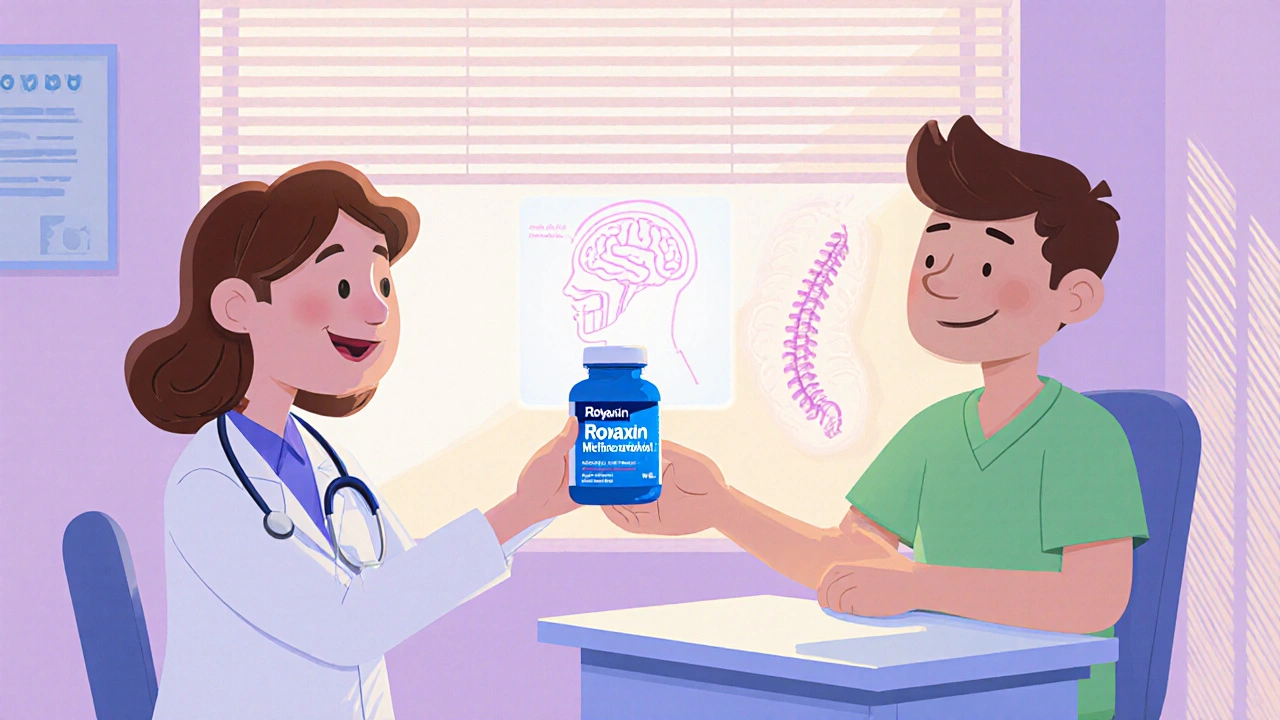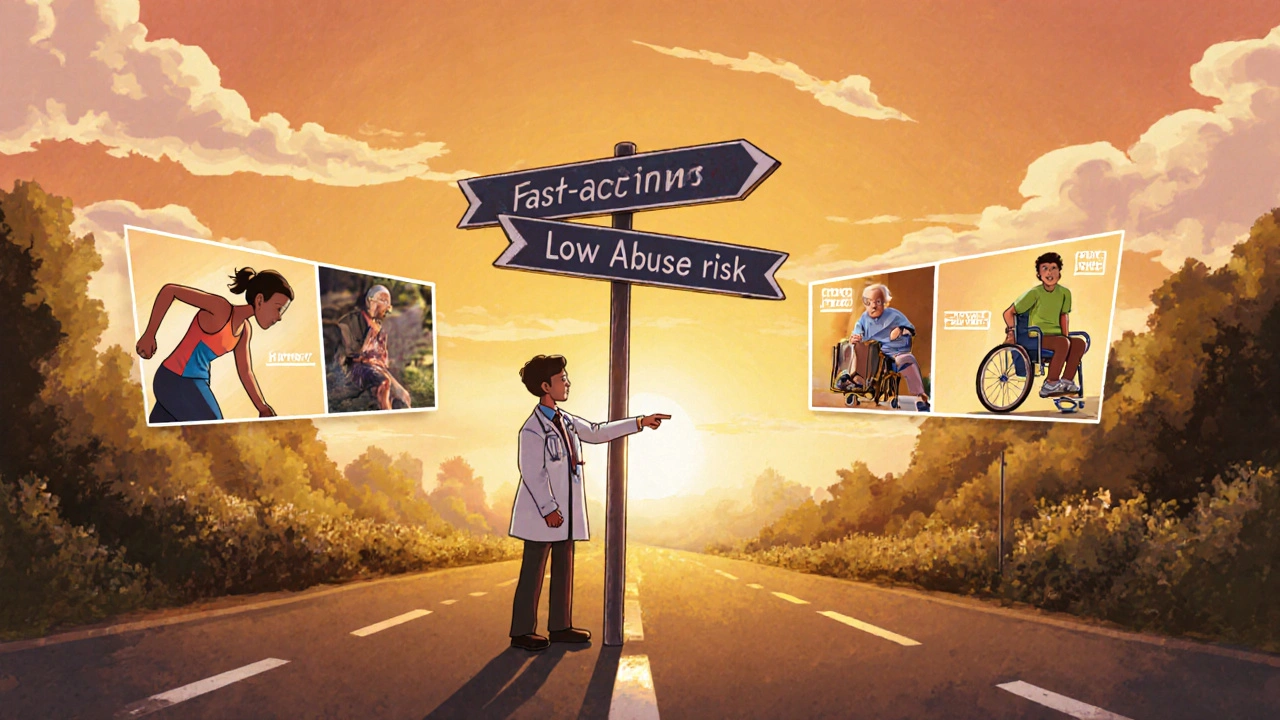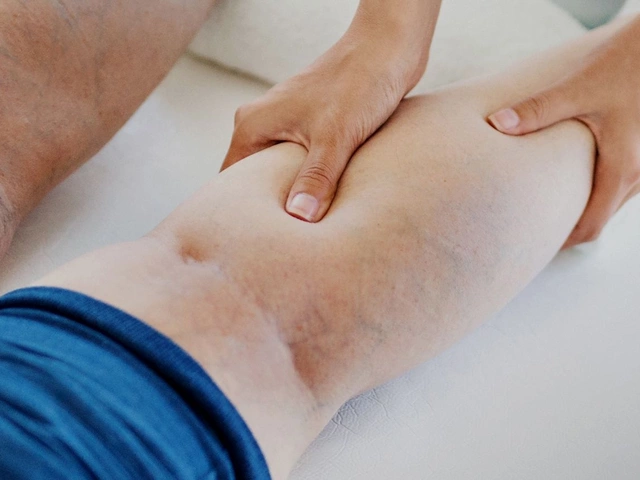Robaxin (Methocarbamol) vs Other Muscle Relaxants: Detailed Comparison

Muscle Relaxant Selection Tool
Muscle Relaxant Selector
Answer a few questions about your situation to identify the most appropriate muscle relaxant for your needs.
Recommended Muscle Relaxants
Quick Takeaways
- Robaxin (Methocarbamol) works by depressing the central nervous system, not by acting directly on muscles.
- Common alternatives - Cyclobenzaprine, Baclofen, Tizanidine, Carisoprodol, Metaxalone - differ in onset speed, duration, and side‑effect profiles.
- Choosing the right relaxant depends on your injury type, other meds, liver/kidney health, and cost.
- Most alternatives require prescription; some have stricter abuse potential (e.g., Carisoprodol).
- Talk to your clinician about drug interactions, especially with CNS depressants or anticoagulants.
What is Robaxin (Methocarbamol)?
Robaxin is a muscle relaxant whose active ingredient is methocarbamol, a centrally acting agent that helps alleviate muscle spasms caused by strains, sprains, or injuries. It was first approved by the FDA in 1957 and is often prescribed alongside NSAIDs or physical therapy.
The drug works by depressing the spinal cord and brain centers that trigger muscle tightening. It does not relax the muscle fibers directly, which is why it’s most effective when the spasm has a neurological component.
Typical adult dosing: 1500 mg four times daily for the first 48 hours, then 1000 mg three times daily. Pediatric dosing is weight‑based and only recommended for children over 12 years.
Common side effects include drowsiness, dizziness, and a mild GI upset. Rare but serious reactions can be allergic skin rashes or liver enzyme elevation.
Why Look at Alternatives?
Not everyone tolerates methocarbamol well. Some patients report excessive sedation, while others need a faster‑acting agent for acute injuries. Insurance formularies may also favor cheaper generics. That’s why clinicians often consider other muscle‑relaxing agents that fit a patient’s specific profile.
Overview of Popular Alternatives
- Cyclobenzaprine - a tricyclic‑derived relaxant, strong anticholinergic effects, good for short‑term use.
- Baclofen - a GABA‑B agonist, excellent for spasticity from multiple sclerosis or spinal cord injury.
- Tizanidine - alpha‑2 adrenergic agonist, rapid onset, useful for nighttime spasms.
- Carisoprodol - metabolizes to meprobamate, high abuse potential, typically limited to 2‑week courses.
- Metaxalone - a non‑sedating option, works slower but has fewer CNS side effects.
Each drug has a distinct mechanism, onset time, duration, and safety profile. Below we break those down side‑by‑side.
Side‑by‑Side Comparison Table
| Drug (Active Ingredient) | Mechanism | Onset (minutes) | Duration (hours) | Typical Adult Dose | Common Side Effects | Abuse Potential |
|---|---|---|---|---|---|---|
| Robaxin (Methocarbamol) | Central nervous system depressant | 30‑60 | 4‑6 | 1500 mg q.i.d. → 1000 mg t.i.d. | Drowsiness, dizziness | Low |
| Cyclobenzaprine | Tricyclic‑like, blocks spinal interneurons | 60‑90 | 6‑8 | 5‑10 mg t.i.d. | Dry mouth, anticholinergic effects | Low‑Moderate |
| Baclofen | GABA‑B receptor agonist | 30‑45 | 3‑4 | 5‑10 mg t.i.d. | Weakness, fatigue | Low |
| Tizanidine | Alpha‑2 adrenergic agonist | 15‑30 | 2‑4 | 2‑4 mg t.i.d. | Dry mouth, hypotension | Low |
| Carisoprodol | Metabolizes to meprobamate (CNS depressant) | 20‑30 | 6‑8 | 350‑700 mg t.i.d. | Drowsiness, dependence | High |
| Metaxalone | Exact mechanism unclear; reduces muscle stiffness | 45‑60 | 5‑7 | 800 mg t.i.d. | GI upset, mild sedation | Low |
How to Choose the Right Muscle Relaxant
Here’s a quick decision checklist you can run through with your doctor:
- Injury type: Acute strain/sprain? Try a fast‑acting agent like Tizanidine. Chronic spasticity? Baclofen may be better.
- Concurrent medications: If you’re already on antidepressants, avoid Cyclobenzaprine due to additive anticholinergic load.
- Liver/kidney health: Methocarbamol is hepatically metabolized; dose down in liver disease.
- Abuse risk: History of substance misuse steers you away from Carisoprodol.
- Cost & insurance: Generics like Metaxalone are often cheaper than brand‑name Robaxin.
Never mix multiple CNS depressants (e.g., alcohol, benzodiazepines) without medical guidance - the combined sedation can be dangerous.
Real‑World Scenarios
Case 1 - A 28‑year‑old runner with a sudden hamstring pull: The doctor prescribed a short 5‑day course of Tizanidine for rapid relief, allowing the athlete to resume light stretching within 48 hours.
Case 2 - A 63‑year‑old with osteoarthritis and mild liver fibrosis: Robaxin was avoided because of hepatic metabolism; Metaxalone provided modest relief without stressing the liver.
Case 3 - A 45‑year‑old with multiple sclerosis‑related spasticity: Baclofen, titrated slowly, reduced leg stiffness and improved gait without excessive drowsiness.

Potential Pitfalls & How to Avoid Them
- Over‑sedation: Start at the lowest dose, especially if you’re also taking antihistamines.
- Drug‑interaction surprises: Methocarbamol can amplify the effect of warfarin; monitor INR if you’re on blood thinners.
- Withdrawal: Sudden stop of Baclofen may cause seizures; taper gradually under supervision.
- Short‑term use only: Muscle relaxants are meant for 2‑3 weeks max; chronic pain should be managed with physio and non‑pharma strategies.
Frequently Asked Questions
Can I take Robaxin with ibuprofen?
Yes, combining methocarbamol with NSAIDs like ibuprofen is common. The relaxant tackles the spasm while ibuprofen reduces inflammation. Just follow dosing guidelines and watch for stomach upset.
Is there a non‑prescription alternative to Robaxin?
Over‑the‑counter options such as topical menthol creams or magnesium supplements can provide mild relief, but they don’t act on the central nervous system like prescription relaxants. If pain is severe, see a clinician.
What should I do if I miss a dose of Methocarbamol?
Take the missed dose as soon as you remember, unless it’s almost time for the next one. Never double‑dose; just continue with the regular schedule.
Are muscle relaxants habit‑forming?
Most, like methocarbamol, baclofen, or cyclobenzaprine, have low abuse potential. Carisoprodol is an exception - it can cause dependence, so doctors limit its use.
Can I drink alcohol while on a muscle relaxant?
It’s safest to avoid alcohol. Both alcohol and CNS depressants increase sedation and can impair coordination, raising fall risk.
Bottom Line
Robaxin (Methocarbamol) remains a solid, low‑abuse option for short‑term muscle spasm relief, but it isn’t a one‑size‑fits‑all. Alternatives like Cyclobenzaprine, Baclofen, Tizanidine, Carisoprodol, and Metaxalone each bring unique strengths and drawbacks. By matching the drug’s profile to your specific condition, other meds you’re taking, and your health history, you can find a safer, more effective path to getting back to motion.






Michael Vandiver
October 22, 2025 AT 18:53Great rundown! 👍 Robaxin is solid and the table makes it easy to compare. Thanks for the clear breakdown 😊
Harini Prakash
October 24, 2025 AT 12:33I appreciate the thoroughness of this post :) The side‑by‑side table really helps when deciding between Tizanidine and Baclofen for acute vs chronic cases. Good job!
Tiffany Davis
October 26, 2025 AT 05:13The note about hepatic metabolism of methocarbamol is useful; patients with liver disease should indeed consider alternatives like Metaxalone.
Iris Joy
October 27, 2025 AT 22:53Building on the table, it’s important to remember that the onset time isn’t the only factor influencing patient adherence. For example, a rapid onset like that of Tizanidine can be advantageous for nighttime spasms, but its antihypertensive effect may be problematic for patients with low baseline blood pressure. Conversely, Cyclobenzaprine’s anticholinergic side‑effects, such as dry mouth and constipation, often limit its use in older adults. Baclofen, while effective for spasticity in multiple sclerosis, can cause generalized weakness if titrated too quickly, which may increase fall risk. Metaxalone’s slower onset may be less appealing for acute injuries, yet its lower CNS sedation profile can be beneficial for patients who need to maintain alertness for work or driving. Regarding liver considerations, methocarbamol is extensively metabolized hepatically, so dose adjustments are recommended in moderate to severe hepatic impairment. Renal clearance is less of a concern for most of these agents, but dose reductions may still be necessary for severe renal dysfunction, particularly with Cyclobenzaprine. Insurance formulary constraints often dictate the first‑line choice; generic Metaxalone is frequently favored for cost reasons, while brand‑name Robaxin may be denied without prior authorization. Drug‑drug interactions remain a key safety issue – all of these relaxants potentiate CNS depressants like benzodiazepines, opioids, and alcohol, increasing the risk of respiratory depression. In patients on anticoagulants, methocarbamol has been reported to augment warfarin effects, so INR monitoring is advisable. Finally, the recommended treatment duration for most muscle relaxants is limited to 2–3 weeks to minimize dependence and tolerance. Physical therapy should be initiated concurrently to address the underlying musculoskeletal issue and reduce reliance on pharmacologic agents.
Bret Toadabush
October 29, 2025 AT 16:33Everyone’s being fed the pharma line – they push Robaxin because it’s cheap and keeps us dependent. They hide the real risks like liver toxicity. Dont trust the “low abuse potential” label; it’s just a PR gimmick.
Sarah Riley
October 31, 2025 AT 10:13The pharmacodynamic profile of methocarbamol indicates a modest GABAergic modulation, which does not substantiate the hyperbolic claims presented.
Tammy Sinz
November 2, 2025 AT 03:53When selecting a muscle relaxant, prioritize the mechanism of action relative to the underlying pathology; Tizanidine’s α‑2 agonism offers rapid nocturnal relief, whereas Baclofen’s GABA‑B activity is superior for spasticity.
Christa Wilson
November 3, 2025 AT 21:33Thanks for the info! 🌟